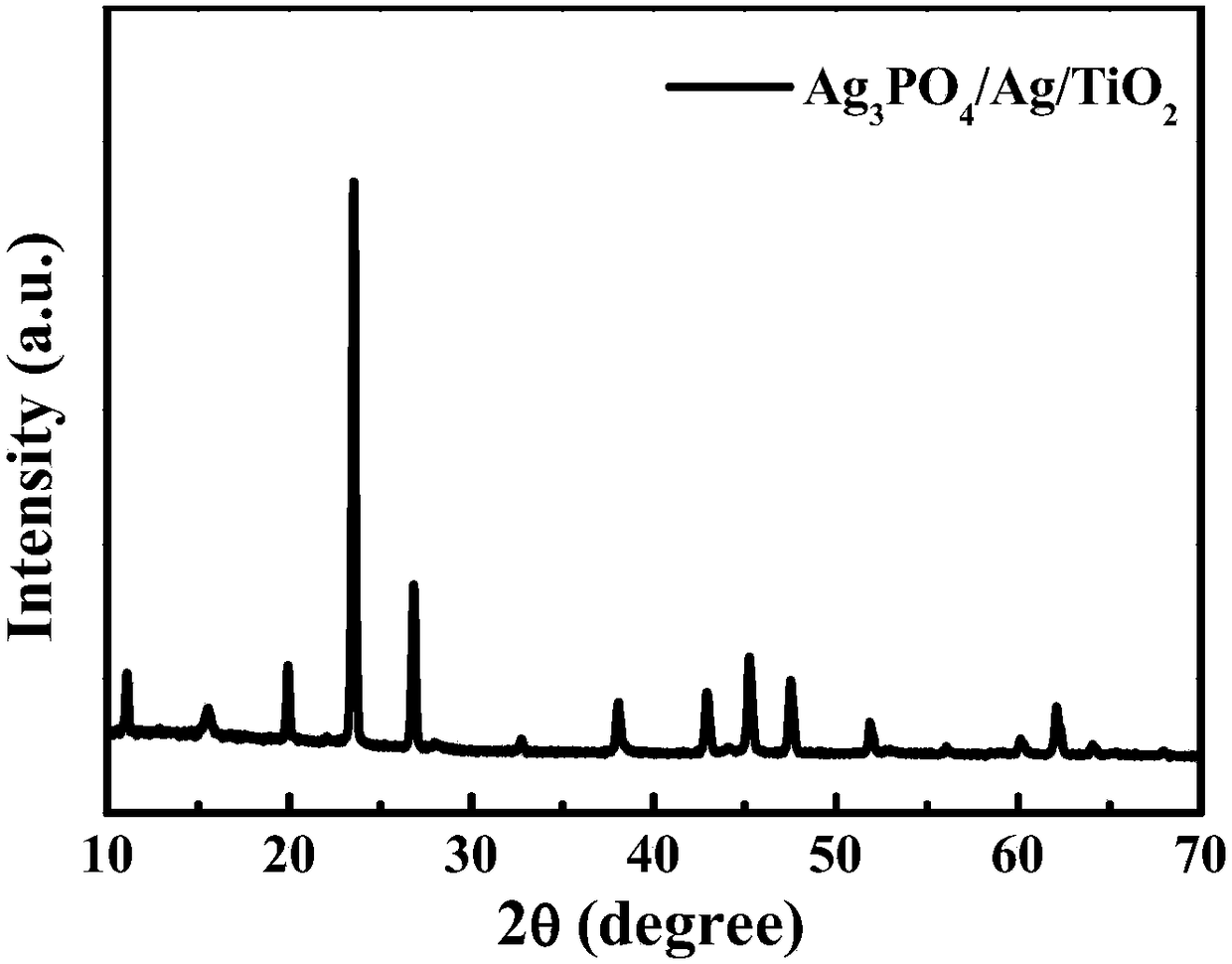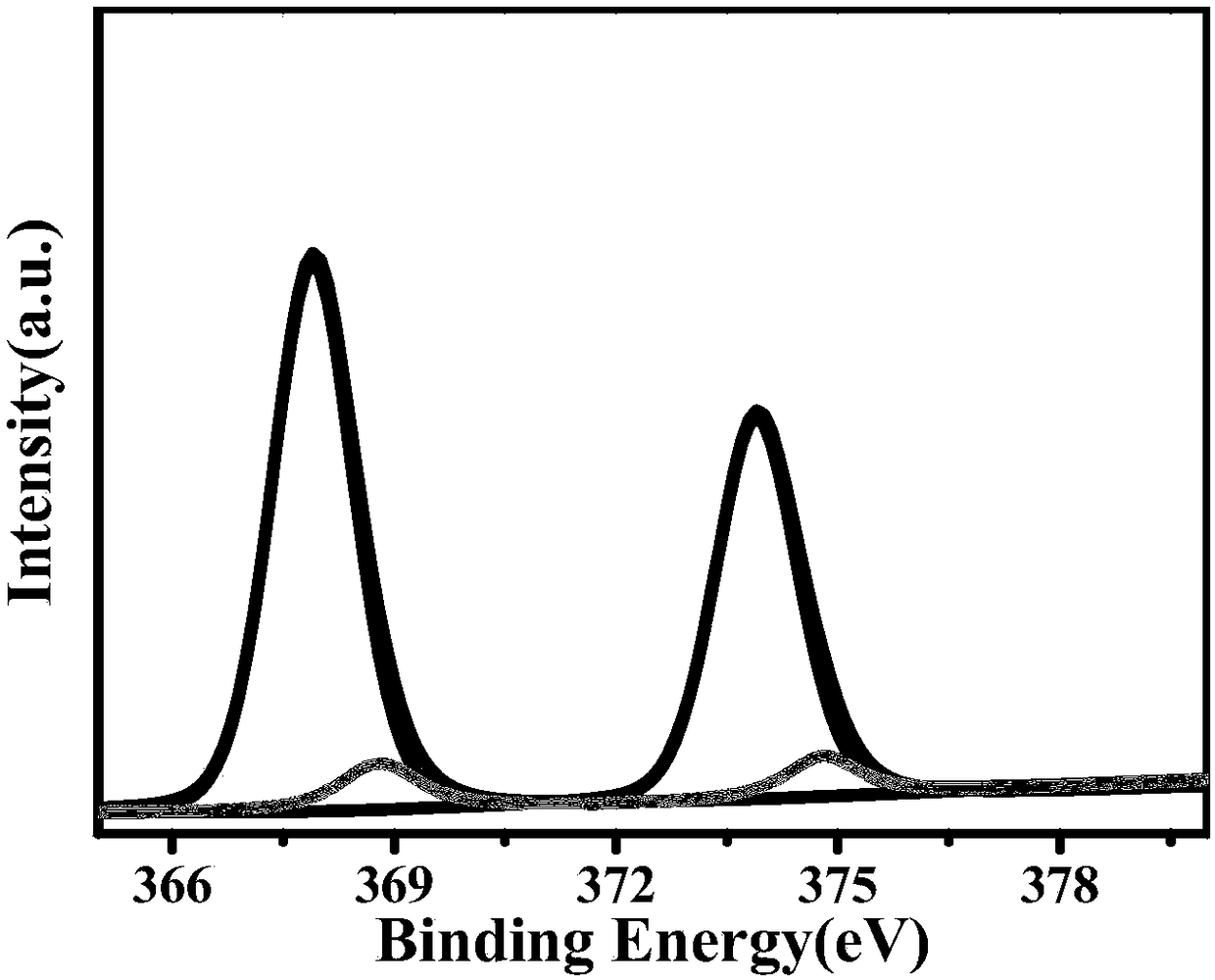Silver phosphate/silver/titanium dioxide nanoflower composite and preparation method and application thereof
A technology of titanium dioxide and composite materials, applied in the field of nanomaterials and photocatalysis, can solve the problems of insufficient light absorption of titanium dioxide, difficulty in photocatalyst recovery, poor stability of silver phosphate, etc., to increase multiple scattering performance, expand absorption range, and increase adsorption sites Effects of points and reaction sites
- Summary
- Abstract
- Description
- Claims
- Application Information
AI Technical Summary
Problems solved by technology
Method used
Image
Examples
Embodiment 1
[0022] Step 1: Add 0.025 mL of diethylenetriamine (EDTA) to 31.5 mL of isopropanol, and stir for 10 min. Then, 1.125 mL of diisopropyl di(acetylacetonato)titanate was added to the solution. Stirring was continued for 10 min. The resulting mixed solution was poured into a reaction kettle, and subjected to solvent heat treatment at 200° C. for 24 hours. After the reaction, the precipitate was washed three times with deionized water and absolute ethanol, placed in an oven at 60°C, dried for 24 hours, and finally placed in a muffle furnace with a heating rate of 1°C / min and a heat treatment temperature of 450°C , and annealed for 2 hours to obtain the precursor titania nanoflower material.
[0023] Step 2: Step 2: Stir and disperse 100mg of the precursor titanium dioxide nanoflower material in 30mL of ethanol, and disperse it evenly with moderate ultrasound; weigh 200mg of silver nitrate and dissolve it in a solution of ammonia water with a mass fraction of 1% and a volume of 10...
Embodiment 2
[0030] Step 1: Add 0.025 mL of diethylenetriamine (EDTA) to 31.5 mL of isopropanol, and stir for 10 min. Then, 1.125 mL of diisopropyl di(acetylacetonato)titanate was added to the solution. Stirring was continued for 10 min. The resulting mixed solution was poured into a reaction kettle, and subjected to solvent heat treatment at 200° C. for 24 hours. After the reaction, the precipitate was washed three times with deionized water and absolute ethanol, placed in an oven at 60°C, dried for 24 hours, and finally placed in a muffle furnace with a heating rate of 1°C / min and a heat treatment temperature of 450°C , and annealed for 2 hours to obtain the precursor titania nanoflower material.
[0031] Step 2: Step 2: Stir and disperse 100mg of the precursor titanium dioxide nanoflower material in 30mL of ethanol, and disperse it evenly with moderate ultrasound; weigh 400mg of silver nitrate and dissolve it in a solution of ammonia water with a mass fraction of 2% and a volume of 10...
Embodiment 3
[0035] Step 1: Add 0.125 mL of diethylenetriamine (EDTA) to 31.5 mL of isopropanol, and stir for 10 min. Then, 4.5 mL of diisopropyl di(acetylacetonato)titanate was added to the solution. Stirring was continued for 10 min. The resulting mixed solution was poured into a reaction kettle, and subjected to solvent heat treatment at 220° C. for 24 hours. After the reaction, the precipitate was washed three times with deionized water and absolute ethanol, placed in a 60°C oven, dried for 24 hours, and finally placed in a muffle furnace with a heating rate of 10°C / min and a heat treatment temperature of 450°C , and annealed for 2 hours to obtain the precursor titania nanoflower material.
[0036] Step 2: Stir and disperse 100mg of the precursor titanium dioxide nanoflower material in 30mL of ethanol, and disperse it evenly with moderate ultrasound; weigh 200mg of silver nitrate and dissolve it in a solution of ammonia water with a mass fraction of 1% and a volume of 10ml to obtain ...
PUM
| Property | Measurement | Unit |
|---|---|---|
| thickness | aaaaa | aaaaa |
| size | aaaaa | aaaaa |
| size | aaaaa | aaaaa |
Abstract
Description
Claims
Application Information
 Login to View More
Login to View More - R&D
- Intellectual Property
- Life Sciences
- Materials
- Tech Scout
- Unparalleled Data Quality
- Higher Quality Content
- 60% Fewer Hallucinations
Browse by: Latest US Patents, China's latest patents, Technical Efficacy Thesaurus, Application Domain, Technology Topic, Popular Technical Reports.
© 2025 PatSnap. All rights reserved.Legal|Privacy policy|Modern Slavery Act Transparency Statement|Sitemap|About US| Contact US: help@patsnap.com



